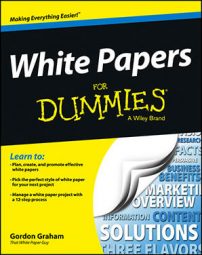Here are ten down-to-earth tips for anyone designing a white paper. If you’re not sure how to design a white paper or you’ve never done one before, read on. If you’re a marketing manager who needs to direct a designer to format your white paper, this is for you. If you’re a white paper writer stuck trying to use Word to turn out respectable-looking pages, you’ve just hit pay dirt.
Design to enhance the content
A white paper isn’t a brochure, so it shouldn’t be as slick and colorful as one. But it needs to be more appealing than your father’s business report. Think of a page from a magazine, like Scientific American or Vanity Fair, or the front part of an annual report, before all the numbers. That kind of crisp, elegant editorial design is what to shoot for with your white paper.Effective design enhances the content of the white paper instead of drawing attention to itself. Your design must add value and clarity to that content instead of adding distractions or hurdles to legibility. Let the white paper’s message shine out from your pages.
Consider your readers' eyesight
Most people’s eyes begin to change in their 40s, and they start to need larger type to read comfortably. By coincidence, most B2B white papers are aimed at business decision makers, most of whom are in their 40s and older. And many people this age prefer to read on paper, so they likely print out a white paper rather than read it on-screen.Younger designers, take note: You’re not designing white papers for yourself and your peers; you’re designing for older people.
That means forget gray text and color backgrounds. Black text on a white background has been the standard for legibility for hundreds of years; why change it? Bump up the body size type to 10 or 11 points; it’s free.
Realize that text isn't a graphic
The text is the content of a white paper. Look at your pages as text-driven content, where your challenge is to make the text as inviting and easy to read or scan as in any magazine you pick up — any magazine, mind you, aimed at people in their 40s and older.Make every page count
Sure, every white paper needs a little front and back matter, but when the front and back matter add up to nearly two-thirds of a white paper, something is terribly wrong.Some misguided software templates lay out a white paper like a two-sided book, with a blank page on the back of the front cover and a back cover to tie it all together. Forget it! Most B2B buyers either look at your white paper on-screen or print it out single sided. Those other pages are just a waste of time and money.
Be sure to compress the front and back matter, cut the worthless blank pages, and make every page count.
Control page breaks
Avoid starting a major section at the very bottom of a page, with only a line or two of text after it or cramming a new section beginning near a footnote or footer.There’s nothing wrong with leaving a little white space at the end of a major section. Just start the new section on a new page. White space gives readers a momentary visual and mental break and helps them understand the structure of the document.
Avoid a wall of gray
Some designers have the idea that a white paper is supposed to be serious, and by that, they think “a wall of gray.” They think all they have to do is just pour the text into the pages and be done with it. Any white paper with text formatted as a wall of gray may look serious, but it won’t invite anyone to read it.Leave lots of white space
Another symptom of the wall-of-gray approach is teensy-tiny, itsy-bitsy, little margins around the text. Long horizontal lines of type are hard for readers’ eyes to scan and tough for their brains to process. If you format a white paper with minimal white space, you’ll lose most of your readers. Again, white space is free.So what if your final document is eight or ten pages long? If the content is compelling and the design is inviting, your readers won’t mind.
Avoid smug shots
So you’re looking for a stock shot for a white paper. That’s a fine way to break up the wall of gray. But by all means, skip the shots of the beautiful people wearing impeccable suits hunched over a pristine PC or shaking hands in some foyer drenched in sunlight. Everyone knows those are fake, posed shots.Pick photos that show average-looking people wearing typical clothes, doing something a little more interesting than shaking hands or peering at computer screens.
Control hyphenation
Most software does a terrible job of hyphenating English. Traditional typography called for at least four letters before any hyphen and at least three letters carried to the second line. Most typographers wouldn’t hyphenate a word with fewer than six letters.So don’t rely on automated hyphenation, and leave your text ragged right. Then scan your right margins, and if you see a major white space that you absolutely must eliminate, take two seconds to insert a manual hyphen.
Refine a corporate template
Some companies have a corporate template that they expect all designers to follow. These layouts may be perfect for a press release, an internal business report, or a data sheet, but they’re not always ideal for a white paper.If you feel strongly that the corporate template detracts from the readability and undermines the white paper content, make your views known. If you have the scope, make up two versions of the white paper: one following the existing template and another with your recommended changes. Circulate both versions to your team, your customer advisory board, and your manager. Get a second opinion from an experienced designer or a white paper expert.

